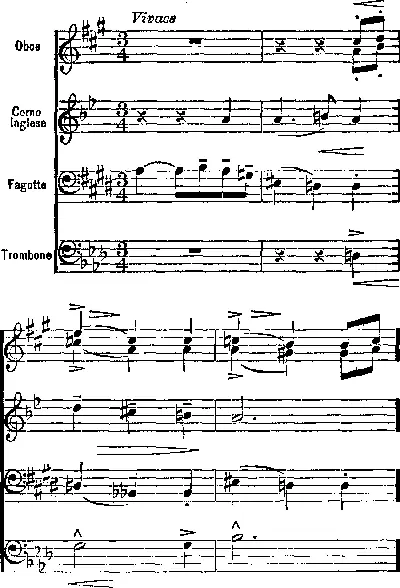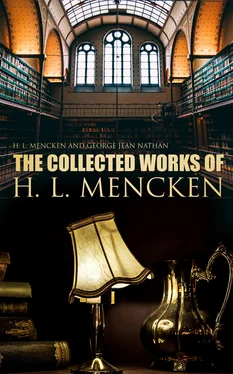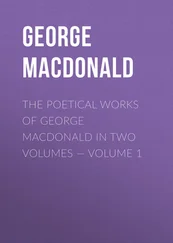George Nathan - The Collected Works of H. L. Mencken
Здесь есть возможность читать онлайн «George Nathan - The Collected Works of H. L. Mencken» — ознакомительный отрывок электронной книги совершенно бесплатно, а после прочтения отрывка купить полную версию. В некоторых случаях можно слушать аудио, скачать через торрент в формате fb2 и присутствует краткое содержание. Жанр: unrecognised, на английском языке. Описание произведения, (предисловие) а так же отзывы посетителей доступны на портале библиотеки ЛибКат.
- Название:The Collected Works of H. L. Mencken
- Автор:
- Жанр:
- Год:неизвестен
- ISBN:нет данных
- Рейтинг книги:4 / 5. Голосов: 1
-
Избранное:Добавить в избранное
- Отзывы:
-
Ваша оценка:
- 80
- 1
- 2
- 3
- 4
- 5
The Collected Works of H. L. Mencken: краткое содержание, описание и аннотация
Предлагаем к чтению аннотацию, описание, краткое содержание или предисловие (зависит от того, что написал сам автор книги «The Collected Works of H. L. Mencken»). Если вы не нашли необходимую информацию о книге — напишите в комментариях, мы постараемся отыскать её.
The Philosophy of Friedrich Nietzsche
A Book of Burlesques
A Book of Prefaces
In Defense of Women
Damn! A Book of Calumny
The American Language
The American Credo
Heliogabalus: A Buffoonery in Three Acts
Ventures Into Verse
The Collected Works of H. L. Mencken — читать онлайн ознакомительный отрывок
Ниже представлен текст книги, разбитый по страницам. Система сохранения места последней прочитанной страницы, позволяет с удобством читать онлайн бесплатно книгу «The Collected Works of H. L. Mencken», без необходимости каждый раз заново искать на чём Вы остановились. Поставьте закладку, и сможете в любой момент перейти на страницу, на которой закончили чтение.
Интервал:
Закладка:

This simple and lovely theme is first sounded, not by any of the usual instruments of the grand orchestra, but by a phonograph in B flat, with the accompaniment of a solitary trombone. When the composition was first played at the Gewandhaus in Leipzig the innovation caused a sensation, and there were loud cries of sacrilege and even proposals of police action. One indignant classicist, in token of his ire, hung a wreath of Knackwürste around the neck of the bust of Johann Sebastian Bach in the Thomaskirche, and appended to it a card bearing the legend, Schweinehund ! But the exquisite beauty of the effect soon won acceptance for the means employed to attain it, and the phonograph has so far made its way with German composers that Prof. Ludwig Grossetrommel, of Göttingen, has even proposed its employment in opera in place of singers.
This motive of lamentation is worked out on a grand scale, and in intimate association with the motives of brooding and of warning. Kraus is not content with the ordinary materials of composition. His creative force is always impelling him to break through the fetters of the diatonic scale, and to find utterance for his ideas in archaic and extremely exotic tonalities. The pentatonic scale is a favorite with him; he employs it as boldly as Wagner did in Das Rheingold . But it is not enough, for he proceeds from it into the Dorian mode of the ancient Greeks, and then into the Phrygian, and then into two of the plagal modes. Moreover, he constantly combines both unrelated scales and antagonistic motives, and invests the combinations in astounding orchestral colors, so that the hearer, unaccustomed to such bold experimentations, is quite lost in the maze. Here, for example, is a characteristic passage for solo French horn and bass piccolo:

The dotted half notes for the horn obviously come from the motive of brooding, in augmentation, but the bass piccolo part is new. It soon appears, however, in various fresh aspects, and in the end it enters into the famous quadruple motive of “sulphur-yellow truth”— schwefelgelbe Wahrheit , as we shall presently see. Its first combination is with a jaunty figure in A minor, and the two together form what most of the commentators agree upon denominating the Zarathustra motive:

I call this the Zarathustra motive, following the weight of critical opinion, but various influential critics dissent. Thus, Dr. Ferdinand Bierfisch, of the Hochschule für Musik at Dresden, insists that it is the theme of “the elevated mood produced by the spiritual isolation and low barometric pressure of the mountains,” while Prof. B. Moll, of Frankfurt a/M., calls it the motive of prowling. Kraus himself, when asked by Dr. Fritz Bratsche, of the Berlin Volkszeitung , shrugged his shoulders and answered in his native Hamburg dialect, “ So gehts im Leben! ’S giebt gar kein Use ”—Such is life; it gives hardly any use (to inquire?). In much the same way Schubert made reply to one who asked the meaning of the opening subject of the slow movement of his C major symphony: “ Halt’s Maul, du verfluchter Narr! ”—Don’t ask such question, my dear sir!
But whatever the truth, the novelty and originality of the theme cannot be denied, for it is in two distinct keys, D major and A minor, and they preserve their identity whenever it appears. The handling of two such diverse tonalities at one time would present insuperable difficulties to a composer less ingenious than Kraus, but he manages it quite simply by founding his whole harmonic scheme upon the tonic triad of D major, with the seventh and ninth added. He thus achieves a chord which also contains the tonic triad of A minor. The same thing is now done with the dominant triads, and half the battle is won. Moreover, the instrumentation shows the same boldness, for the double theme is first given to three solo violins, and they are muted in a novel and effective manner by stopping their F holes. The directions in the score say mit Glaserkitt (that is, with glazier’s putty), but the Konzertmeister at the Gewandhaus, Herr F. Dur, substituted ordinary pumpernickel with excellent results. It is, in fact, now commonly used in the German orchestras in place of putty, for it does less injury to the varnish of the violins, and, besides, it is edible after use. It produces a thick, oily, mysterious, far-away effect.
At the start, as I have just said, the double theme of Zarathustra appears in D major and A minor, but there is quick modulation to B flat major and C sharp minor, and then to C major and F sharp minor. Meanwhile the tempo gradually accelerates, and the polyphonic texture is helped out by reminiscences of the themes of brooding and of lamentation. A sudden hush and the motive of warning is heard high in the wood-wind, in C flat major, against a double organ-point—C natural and C sharp—in the lower strings. There follows a cadenza of no less than eighty-four measures for four harps, tympani and a single tuba, and then the motive of waiting is given out by the whole orchestra in unison:

This stately motive is repeated in F major, after which some passage work for the piano and pianola, the former tuned a quarter tone lower than the latter and played by three performers, leads directly into the quadruple theme of the sulphur-yellow truth, mentioned above. It is first given out by two oboes divided, a single English horn, two bassoons in unison, and four trombones in unison. It is an extraordinarily long motive, running to twenty-seven measures on its first appearance; the four opening measures are given on the next page.

With an exception yet to be noted, all of the composer’s thematic material is now set forth, and what follows is a stupendous development of it, so complex that no written description could even faintly indicate its character. The quadruple theme of the sulphur-yellow truth is sung almost uninterruptedly, first by the wood-wind, then by the strings and then by the full brass choir, with the glockenspiel and cymbals added. Into it are woven all of the other themes in inextricable whirls and whorls of sound, and in most amazing combinations and permutations of tonalities. Moreover, there is a constantly rising complexity of rhythm, and on one page of the score the time signature is changed no less than eighteen times. Several times it is 5-8 and 7-4; once it is 11-2; in one place the composer, following Koechlin and Erik Satie, abandons bar-lines altogether for half a page of the score. And these diverse rhythms are not always merely successive; sometimes they are heard together. For example, the motive of disaster, augmented to 5-8 time, is sounded clearly by the clarinets against the motive of lamentation in 3-4 time, and through it all one hears the steady beat of the motive of waiting in 4-4!
This gigantic development of materials is carried to a thrilling climax, with the whole orchestra proclaiming the Zarathustra motive fortissimo . Then follows a series of arpeggios for the harps, made of the motive of warning, and out of them there gradually steals the tonic triad of D minor, sung by three oboes. This chord constitutes the backbone of all that follows. The three oboes are presently joined by a fourth. Against this curtain of tone the flutes and piccolos repeat the theme of brooding in F major, and then join the oboes in the D minor chord. The horns and bassoons follow with the motive of disaster and then do likewise. Now come the violins with the motive of lamentation, but instead of ending with the D minor tonic triad, they sound a chord of the seventh erected on C sharp as seventh of D minor. Every tone of the scale of D minor is now being sounded, and as instrument after instrument joins in the effect is indescribably sonorous and imposing. Meanwhile, there is a steady crescendo , ending after three minutes of truly tremendous music with ten sharp blasts of the double chord. A moment of silence and a single trombone gives out a theme hitherto not heard. It is the theme of tenderness, or, as the German commentators call it, the Biermad’l Motiv : Thus:
Читать дальшеИнтервал:
Закладка:
Похожие книги на «The Collected Works of H. L. Mencken»
Представляем Вашему вниманию похожие книги на «The Collected Works of H. L. Mencken» списком для выбора. Мы отобрали схожую по названию и смыслу литературу в надежде предоставить читателям больше вариантов отыскать новые, интересные, ещё непрочитанные произведения.
Обсуждение, отзывы о книге «The Collected Works of H. L. Mencken» и просто собственные мнения читателей. Оставьте ваши комментарии, напишите, что Вы думаете о произведении, его смысле или главных героях. Укажите что конкретно понравилось, а что нет, и почему Вы так считаете.












